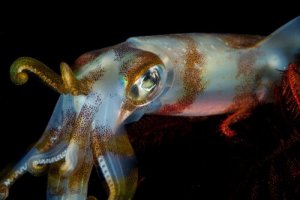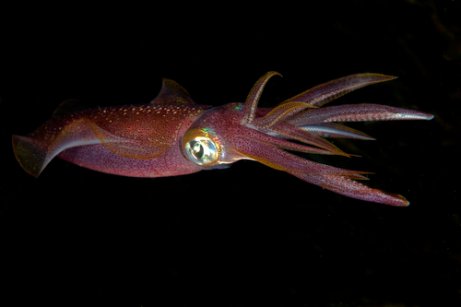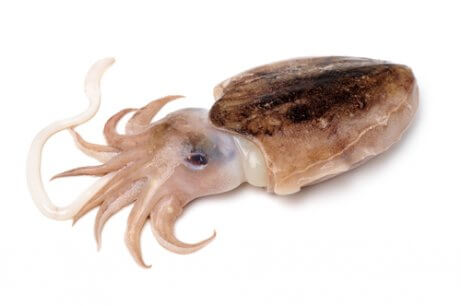What Are the Differences Between Squid and Cuttlefish?


Written and verified by the lawyer Francisco María García
Although both animals are mollusks that look similar in many ways, there are several differences between squid and cuttlefish. Today we’re going to tell you more about each animal to help you recognize the differences.
Important characteristics of squids
Squids are cephalopod mollusks that make up the order of Teuthida. In this order, there are two suborders, Oegopsina and Myopsina, which encompass the different species of squid that we know of today.
The Oegopsina suborder is made up of several families from diverse species, including the famous giant squid. On the other hand, one family makes up the suborder Myopsina, called Loliginidae.
Squids are carnivorous and invertebrate marine animals, which are related to cuttlefish, octopus, and nautilus. Anatomically, they are characterized by their two main tentacles and eight arms.
Other characteristics of squid
Squids’ tentacles are muscular, with powerful suckers or suction cups on them. Some species, such as the giant squid, are able to regrow their tentacles. This is helpful in case of an injury. They also sometimes deliberately detach their tentacles in an attempt to escape from a predator.
Another typical characteristic of squids is their peculiar circulatory system. Two branchial hearts and one systematic heart make up this system. The branchial hearts pump blood to the two gills and the systematic heart pumps blood to the rest of the body. Keep in mind that squids have two gills to enable them to breathe in aquatic ecosystems.

Squid and the ability to camouflage
Squids have special cells on their skin, known as chromatophores. These contain pigments and are able to reflect the light.
In addition to providing color to their skin, these cells also allow the animal to change color easily. This then allows the squid to camouflage itself with its environment. As well as this defense strategy, squids can also eject ink to confuse their predators. This gives them time to escape.
A high concentration of chromatophores also explains why squids generally have very striking coloring. In fact, you can see a large variety of coloring and patterns among the different species.
General characteristics of cuttlefish
Cuttlefish are also cephalopod mollusks, but belong to the order of Sepiida. In this order, there are more than 100 species of cuttlefish.
Cuttlefish are medium-sized mollusks and grow up to 16 inches in length in adulthood. They have oval-shaped bodies. Their bodies also appear slightly flattened.
One of the most interesting features, however, are the 10 irregular tentacles concentrated around the mouth. Out of the five pairs of tentacles, five are shorter and have two rows of small suckers each.

The longest pair of tentacles is retractable and usually triples in size compared to the other tentacles. On the ends of these longer tentacles are several irregular suckers. These long tentacles are crucial in helping the cuttlefish capture prey. They are also fundamental during reproduction.
Similarities and differences between squid and cuttlefish
Now that you are a bit more familiar with these aquatic animals, you can start to notice the similarities and differences between squid and cuttlefish. However, any similarities between these species aren’t accidental. They are genetically similar, which leads to similarities in their anatomy and physiology.
However, one main difference between squid and cuttlefish is their appearance. While cuttlefish have an oval body and appear slightly flattened, squids are more elongated and cylindrical.
Another difference between squid and cuttlefish is in their size. Cuttlefish can measure up to 16 inches, while squid are usually about 24 inches in length. There are even some species of squid, such as the giant squid, that can exceed 50 feet in length.
It’s also interesting to note that squids have two tentacles and eight arms with suckers. On the other hand, cuttlefish have 10 tentacles near their mouths, which are noticeably smaller than the squid’s.
Another important difference between squid and cuttlefish is the shape of their internal shells. A squid’s is thin, flat, transparent, and made of cartilage. They also appear to have the shape of a feather.
On the contrary, the internal shell of a cuttlefish is spoon-shaped. Calcium carbonate makes up most of the shell, which gives it a white color. This is another distinct difference between the two species.
Although both animals are mollusks that look similar in many ways, there are several differences between squid and cuttlefish. Today we’re going to tell you more about each animal to help you recognize the differences.
Important characteristics of squids
Squids are cephalopod mollusks that make up the order of Teuthida. In this order, there are two suborders, Oegopsina and Myopsina, which encompass the different species of squid that we know of today.
The Oegopsina suborder is made up of several families from diverse species, including the famous giant squid. On the other hand, one family makes up the suborder Myopsina, called Loliginidae.
Squids are carnivorous and invertebrate marine animals, which are related to cuttlefish, octopus, and nautilus. Anatomically, they are characterized by their two main tentacles and eight arms.
Other characteristics of squid
Squids’ tentacles are muscular, with powerful suckers or suction cups on them. Some species, such as the giant squid, are able to regrow their tentacles. This is helpful in case of an injury. They also sometimes deliberately detach their tentacles in an attempt to escape from a predator.
Another typical characteristic of squids is their peculiar circulatory system. Two branchial hearts and one systematic heart make up this system. The branchial hearts pump blood to the two gills and the systematic heart pumps blood to the rest of the body. Keep in mind that squids have two gills to enable them to breathe in aquatic ecosystems.

Squid and the ability to camouflage
Squids have special cells on their skin, known as chromatophores. These contain pigments and are able to reflect the light.
In addition to providing color to their skin, these cells also allow the animal to change color easily. This then allows the squid to camouflage itself with its environment. As well as this defense strategy, squids can also eject ink to confuse their predators. This gives them time to escape.
A high concentration of chromatophores also explains why squids generally have very striking coloring. In fact, you can see a large variety of coloring and patterns among the different species.
General characteristics of cuttlefish
Cuttlefish are also cephalopod mollusks, but belong to the order of Sepiida. In this order, there are more than 100 species of cuttlefish.
Cuttlefish are medium-sized mollusks and grow up to 16 inches in length in adulthood. They have oval-shaped bodies. Their bodies also appear slightly flattened.
One of the most interesting features, however, are the 10 irregular tentacles concentrated around the mouth. Out of the five pairs of tentacles, five are shorter and have two rows of small suckers each.

The longest pair of tentacles is retractable and usually triples in size compared to the other tentacles. On the ends of these longer tentacles are several irregular suckers. These long tentacles are crucial in helping the cuttlefish capture prey. They are also fundamental during reproduction.
Similarities and differences between squid and cuttlefish
Now that you are a bit more familiar with these aquatic animals, you can start to notice the similarities and differences between squid and cuttlefish. However, any similarities between these species aren’t accidental. They are genetically similar, which leads to similarities in their anatomy and physiology.
However, one main difference between squid and cuttlefish is their appearance. While cuttlefish have an oval body and appear slightly flattened, squids are more elongated and cylindrical.
Another difference between squid and cuttlefish is in their size. Cuttlefish can measure up to 16 inches, while squid are usually about 24 inches in length. There are even some species of squid, such as the giant squid, that can exceed 50 feet in length.
It’s also interesting to note that squids have two tentacles and eight arms with suckers. On the other hand, cuttlefish have 10 tentacles near their mouths, which are noticeably smaller than the squid’s.
Another important difference between squid and cuttlefish is the shape of their internal shells. A squid’s is thin, flat, transparent, and made of cartilage. They also appear to have the shape of a feather.
On the contrary, the internal shell of a cuttlefish is spoon-shaped. Calcium carbonate makes up most of the shell, which gives it a white color. This is another distinct difference between the two species.
This text is provided for informational purposes only and does not replace consultation with a professional. If in doubt, consult your specialist.








